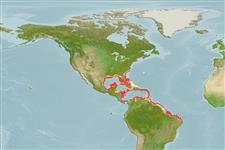Gastropoda |
Littorinimorpha |
Ranellidae
Environment: milieu / climate zone / εύρος βάθους / distribution range
Οικολογία
Υφαλόφιλο(α); εύρος βάθους 1 - 384 m (Αναφ. 83934). Tropical; 34°N - 17°S, 97°E - 0°E (Αναφ. 83435)
Western Atlantic and the Mediterranean.
In the past identified as Charonia tritonis in the Mediterranean.
Length at first maturity / Μέγεθος / Weight / Age
Γεννητική Ωρίμανση: Lm ? range ? - ? cm Max length : 37.4 cm DL αρσενικό/απροσδιόριστο; (Αναφ. 83435); common length : 33.0 cm TL αρσενικό/απροσδιόριστο; (Αναφ. 355)
Shell elongate, large, heavy. Spire pointed, elongate. Anterior canal very short. Varices present on last whorls. Parietal region with narrow dark brown inner lip covered by regularly spaced, spirally oriented, white, cord-like plicae. Outer lip internally with pairs of fine white teeth superimposed on square blotches of dark brown colour. Colour: cream white with brown markings, usually crescent-shaped.
This species is found shallow subtidal (Ref. 355), and on offshore coral reefs and cienaga facies, particularly on algae, boulder, coral, rock, sand and shell habitats (Ref. 83934).
Life cycle and mating behavior
Γεννητική Ωρίμανση | Αναπαραγωγή | Γεννοβολία | Eggs | Γονιμότητα | Larvae
Members of the order Neotaenioglossa are mostly gonochoric and broadcast spawners. Life cycle: Embryos develop into planktonic trocophore larvae and later into juvenile veligers before becoming fully grown adults.
Leal, J.H. 2003 Gastropods. p. 99-147. In Carpenter, K.E. (ed.). The living marine resources of the Western Central Atlantic. Volume 1: Introduction, molluscs, crustaceans, hagfishes, sharks, batoid fishes, and chimaeras. FAO Species Identification Guide for Fishery Purposes and American Society of Ichthyologists and Herpetologists Special Publication No. 5. 1600p. (Αναφ. 355)
IUCN Red List Status
(Αναφ. 130435: Version 2025-1)
CITES status (Αναφ. 108899)
Not Evaluated
Not Evaluated
Threat to humans
Human uses
αλιεία: Εμπορικό(ά)
| FishSource |
Εργαλεία
Περισσότερες πληροφορίες
Population dynamicsΑύξησηMax. ages / sizesLength-weight rel.Length-length rel.Length-frequenciesMass conversionΑφθονία Life cycleΑναπαραγωγήΓεννητική ΩρίμανσηΓονιμότηταΓεννοβολίαEggsEgg developmentLarvae PhysiologyΚατανάλωση οξυγόνου
Human RelatedStamps, coins, misc.
Διαδικτυακές πηγές
Estimates based on models
Preferred temperature
(Ref.
115969): 17.9 - 27.1, mean 23.8 (based on 157 cells).
Fishing Vulnerability
Low to moderate vulnerability (27 of 100).
Price category
Unknown.
